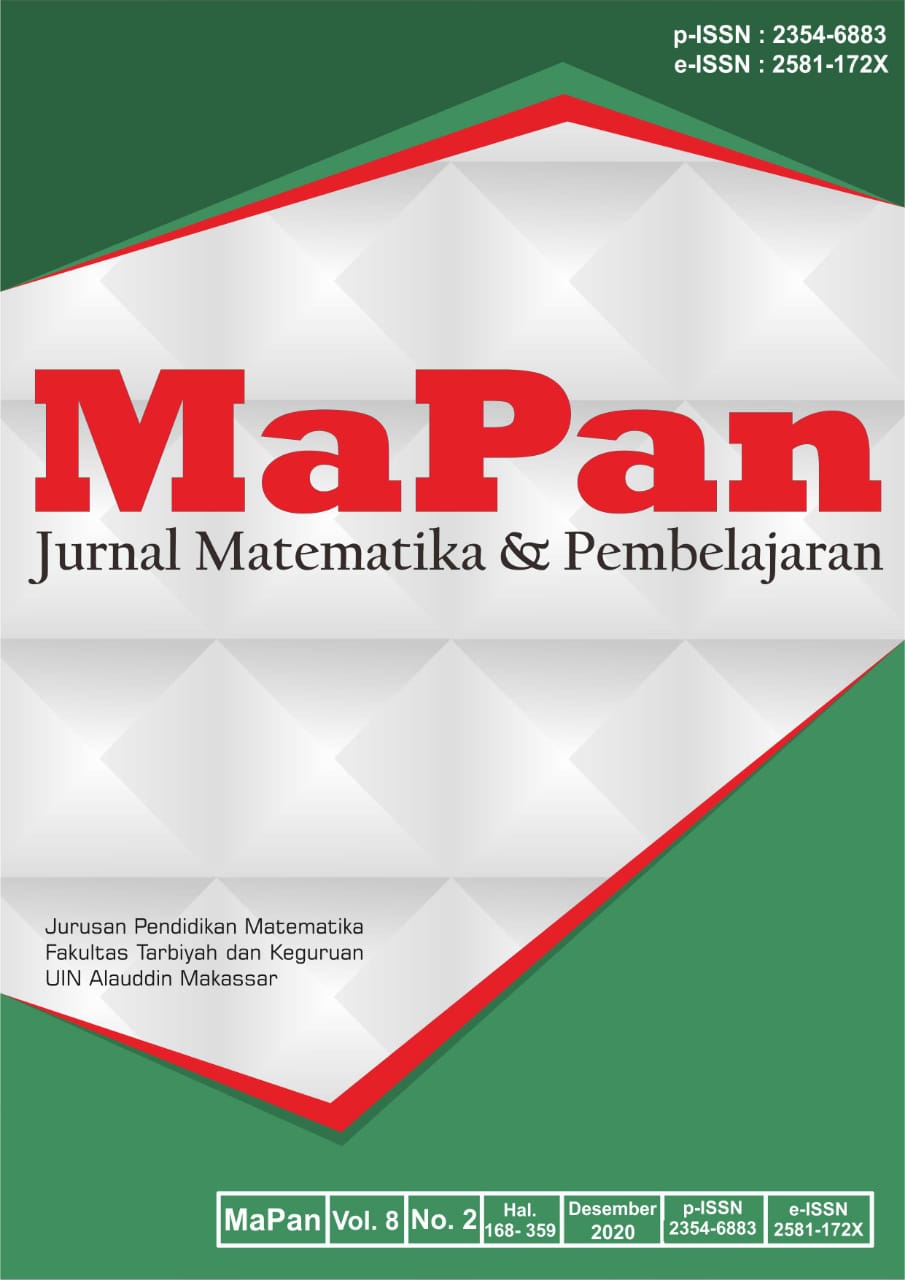ANALYSIS OF HIGHER ORDER THINKING SKILLS (HOTS) IN MATHEMATICAL PROBLEM SOLVING BASED ON REVISED BLOOMS’ TAXONOMY VIEWED FROM GENDER EQUALITY
Abstract
This study aims to determine the description of the results of the analysis of higher order thinking skills in mathematics problem solving based on revised Bloom's taxonomy viewed from gender equality. The subject of the research is two students of SMPN 1 Takalar selected using a purposive sampling technique. The type of research used is descriptive research with a qualitative approach. The description was obtained by analyzing the tests of higher order thinking skills in mathematical problem solving. In this study, instruments in the form of questions test higher order thinking skills based on revised Bloom's taxonomy and the interview guideline. Data collection techniques in the form of test, interview, observation, and documentation. The data analysis technique was data reduction, data presentation, and conclusion drawing/verification. The results of the research show that subjects can use their skills even though still not achieved optimally. Both subjects use almost all aspects of thinking skills based on the revised Bloom's taxonomy, either directly or to bridge the subject in constructing the higher order thinking skills. It shows the difference in students' higher order thinking skills from each category, namely the male and female categories.Downloads
References
Anderson, L. W., & Krathwohl, D. R. (2010). Framework foundation for learning, teaching, and assessment. Yogyakarta: Pustaka Pelajar.
Anjarsari, P. (2014). The Importance of the train thinking skills (thinking skills) in SCIENCE learning. Optimalisasi Implementasi Kurikulum 2013, 1–10. Retrieved from http://staff.uny.ac.id/sites/default/files/pengabdian/ putri-anjarsari-ssi-mpd/pentingnya-melatih-keterampilan-berpikir-criti cal-thinking-dalam-pembelajaran-ipa-smp.pdf.
Ariyana, Y., Pudjiastuti, A., Bestary, R., & Zamroni. (2018). Handbook skills a high level of thinking based zoning. Direktorat Jendral Guru dan Tenaga Kependidikan dan Kebudayaan.
Brookhart, S. M. (2010). How to Assess Higher Order Thinking Skill in Your Classroom. Virginia USA: Alexandria. Retrieved from http://www.ascd. org/memberbooks.
Depdiknas. (2006). Peraturan menteri pendidikan nasional nomor 22 Tahun 2006 tentang standar konten. 58 mei. Jakarta: Depdiknas.
Dimyanti, & Mudjiono. (2013). Learning and Learning. Jakarta: Rineka Cipta.
Fatmawati, H., Mardiyana, & Triyanto. (2014). The analysis of students’ critical thinking in solving mathematical problems based on polya on the subject of quadratic equations. Jurnal Elektronik Pembelajaran Matematika, 2(9), 899–910. Retrieved from https://osf.io/preprints/inarxiv/wsza9/.
Heong, Y. M., Othman, W. B., Yunos, J. B. M., Kiong, T. T., Hassan, R. Bin, & Mohamad, M. M. B. (2011). The level of marzano higher order thinking skills among technical education students. International Journal of Social Science and Humanity, 1(2), 121–125. https://doi.org/10.7763/ijssh.2011. v1.20.
Kawuwung, F. (2011). Profile of teachers, understanding cooperative NHT, and the ability of high level thinking in the junior north minahasa regency. El–Hayah, 1(4), 157–166. https://doi.org/10.18860/elha.v1i4. 1693.
Miles, M. B., & Huberman, A. M. (1992). Qualitative data analysis. Beverly Hills, CA: Sage.
Mulyadi. (2010). Diagnosis of learning difficulties and guidance against special learning difficulties. Yogyakarta: NuhaLitera.
OECD. (2014). PISA 2012 results in focus: What 15 years olds know and what they can do with what they know. Paris: OECD Publishing.
Polya, G. (1973). Reviewed work: how to solve it by g. polya. The Mathematical Gazette, 30, 181-182. https://doi.org/10.2307/3609122.
Santrock, J. W. (2011). The development of the child. Jakarta: Erlangga.
Saputri, R. R., Sugiarti, T., Murtikusuma, R. P., Trapsilasiwi, D., & Yudianto, E. (2018). Analisis kesalahan siswa dalam menyelesaikan soal materi fungsi berdasarkan kriteria watson ditinjau dari perbedaan gender siswa SMP kelas VIII. Kadikma, 9(2), 59–68. Retrieved from https://jurnal.unej.ac.id/index.php/kadikma/article/view/9710.
Sugiyono. (2014). Metode penelitian pendidikan (pendekatan kuantitatif, kualititatif, dan R&D). Bandung: Alfabeta.
Sulaiman, T., Muniyan, V., Madhvan, D., Hasan, R., & Rahim, S. S. A. (2017). Implementation of higher order thinking skills in teaching of science: a case study in Malaysia. International Research Journal of Education and Sciences, 1(1), 1–3. Retrieved from https://www.masree.info/wp-content/uploads/2019/11/Implementation-of-Higher-Order-Thinking-Skills-in-Teaching-of-Science.pdf.
Copyright (c) 2020 Ernawati, Baharullah

This work is licensed under a Creative Commons Attribution 4.0 International License.


